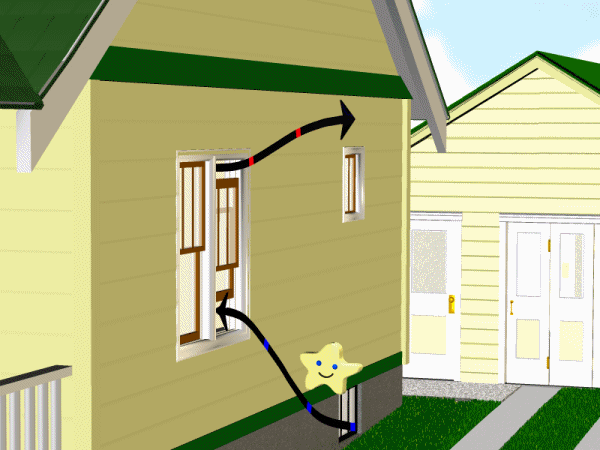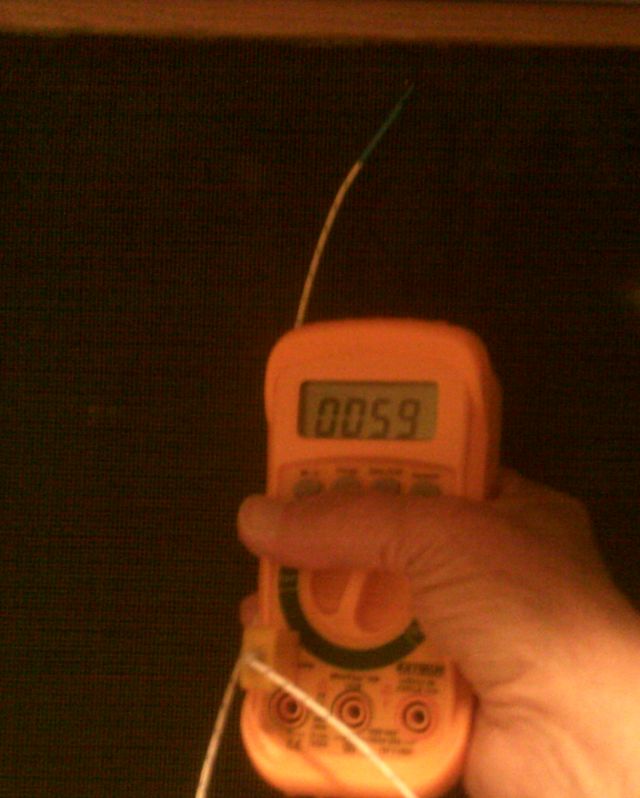Sunday, November 29, 2015
Double-hung sashes WORK.
Polistra has approached this point a couple times without any conclusions.
 The double-hung sash was originally meant to assist ventilation in summer. Supposedly cooler air comes in at the bottom and warmer air exits at the top. Very few people actually used both sashes, so the upper sash usually ended up static. It was either painted shut or physically locked with steel or wooden brackets. Windows made after 1940 pretty much abandoned the pretense of an openable upper.
During last week's power outage I was keeping my 'sciencey' mind occupied by measuring temperatures in various places. At one point I tried checking outside temp without actually going outside, by poking the thermocouple through the screen. Got a surprisingly high reading. Realized that I was at the top of this little window, so just for fun tried the bottom.
The double-hung sash was originally meant to assist ventilation in summer. Supposedly cooler air comes in at the bottom and warmer air exits at the top. Very few people actually used both sashes, so the upper sash usually ended up static. It was either painted shut or physically locked with steel or wooden brackets. Windows made after 1940 pretty much abandoned the pretense of an openable upper.
During last week's power outage I was keeping my 'sciencey' mind occupied by measuring temperatures in various places. At one point I tried checking outside temp without actually going outside, by poking the thermocouple through the screen. Got a surprisingly high reading. Realized that I was at the top of this little window, so just for fun tried the bottom.

 These pix were made right now, with blessed light and blessed heat inside, so the delta is larger than it was during the outage. Ambient in the room is 62; outside temp as given by the Weather Bureau is 19. But even with 45 inside during the outage, the delta was still there.
Conclusion: The cold-in warm-out effect doesn't require two openings or a tall window. Even on this single 18" high window, the in and out are SHARPLY separated.
Later, tried to watch the flow direction with a match. The inflow at bottom is strong; outflow at top is weak.
These pix were made right now, with blessed light and blessed heat inside, so the delta is larger than it was during the outage. Ambient in the room is 62; outside temp as given by the Weather Bureau is 19. But even with 45 inside during the outage, the delta was still there.
Conclusion: The cold-in warm-out effect doesn't require two openings or a tall window. Even on this single 18" high window, the in and out are SHARPLY separated.
Later, tried to watch the flow direction with a match. The inflow at bottom is strong; outflow at top is weak.
 The double-hung sash was originally meant to assist ventilation in summer. Supposedly cooler air comes in at the bottom and warmer air exits at the top. Very few people actually used both sashes, so the upper sash usually ended up static. It was either painted shut or physically locked with steel or wooden brackets. Windows made after 1940 pretty much abandoned the pretense of an openable upper.
During last week's power outage I was keeping my 'sciencey' mind occupied by measuring temperatures in various places. At one point I tried checking outside temp without actually going outside, by poking the thermocouple through the screen. Got a surprisingly high reading. Realized that I was at the top of this little window, so just for fun tried the bottom.
The double-hung sash was originally meant to assist ventilation in summer. Supposedly cooler air comes in at the bottom and warmer air exits at the top. Very few people actually used both sashes, so the upper sash usually ended up static. It was either painted shut or physically locked with steel or wooden brackets. Windows made after 1940 pretty much abandoned the pretense of an openable upper.
During last week's power outage I was keeping my 'sciencey' mind occupied by measuring temperatures in various places. At one point I tried checking outside temp without actually going outside, by poking the thermocouple through the screen. Got a surprisingly high reading. Realized that I was at the top of this little window, so just for fun tried the bottom.

 These pix were made right now, with blessed light and blessed heat inside, so the delta is larger than it was during the outage. Ambient in the room is 62; outside temp as given by the Weather Bureau is 19. But even with 45 inside during the outage, the delta was still there.
Conclusion: The cold-in warm-out effect doesn't require two openings or a tall window. Even on this single 18" high window, the in and out are SHARPLY separated.
Later, tried to watch the flow direction with a match. The inflow at bottom is strong; outflow at top is weak.
These pix were made right now, with blessed light and blessed heat inside, so the delta is larger than it was during the outage. Ambient in the room is 62; outside temp as given by the Weather Bureau is 19. But even with 45 inside during the outage, the delta was still there.
Conclusion: The cold-in warm-out effect doesn't require two openings or a tall window. Even on this single 18" high window, the in and out are SHARPLY separated.
Later, tried to watch the flow direction with a match. The inflow at bottom is strong; outflow at top is weak.Labels: Metrology
